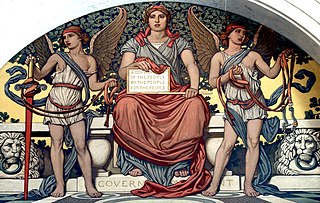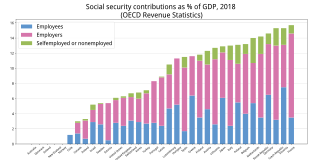Notes
- ↑ "Addressing social problems should be at the heart of Europe's economic strategy". Brueghel. Retrieved 2014-05-07.
| In the Western world |
| ||||
|---|---|---|---|---|---|
| Country-specific |
| ||||
| Types | |||||
| Concepts | |||||
| Related | |||||
The intergenerational struggle [1] is the economic conflict between successive generations of workers because of the public pension system where the first generation has better pension benefit and the last must pay more taxes, have a greater tax wedge and a lower pension benefit due to the public debt that the states make in order to pay the current public spending.

A pension is a fund into which amounts are paid regularly during an individual's working career, and from which periodic payments are made to support the person's retirement from work. A pension may be:

A country's gross government debt is the financial liabilities of the government sector. Changes in government debt over time reflect primarily borrowing due to past government deficits. A deficit occurs when a government's expenditures exceed revenues. Government debt may be owed to domestic residents, as well as to foreign residents. If owed to foreign residents, that quantity is included in the country's external debt.
Tax advantage refers to the economic bonus which applies to certain accounts or investments that are, by statute, tax-reduced, tax-deferred, or tax-free. Examples of tax-advantaged accounts and investments include retirement plans, education savings accounts, medical savings accounts, and government bonds. Governments establish tax advantages to encourage private individuals to contribute money when it is considered to be in the public interest.

Social insurance is a form of social welfare that provides insurance against economic risks. The insurance may be provided publicly or through the subsidizing of private insurance. In contrast to other forms of social assistance, individuals' claims are partly dependent on their contributions, which can be considered insurance premiums to create a common fund out of which the individuals are then paid benefits in the future.
The Social Security debate in the United States encompasses benefits, funding, and other issues. Social Security is a social insurance program officially called "Old-age, Survivors, and Disability Insurance" (OASDI), in reference to its three components. It is primarily funded through a dedicated payroll tax. During 2015, total benefits of $897 billion were paid out versus $920 billion in income, a $23 billion annual surplus. Excluding interest of $93 billion, the program had a cash deficit of $70 billion. Social Security represents approximately 40% of the income of the elderly, with 53% of married couples and 74% of unmarried persons receiving 50% or more of their income from the program. An estimated 169 million people paid into the program and 60 million received benefits in 2015, roughly 2.82 workers per beneficiary. Reform proposals continue to circulate with some urgency, due to a long-term funding challenge faced by the program as the ratio of workers to beneficiaries falls, driven by the aging of the baby-boom generation, expected continuing low birth rate, and increasing life expectancy. Program payouts began exceeding cash program revenues in 2011; this shortfall is expected to continue indefinitely under current law.

Employee benefits and benefits in kind, also called fringe benefits, perquisites, or perks, include various types of non-wage compensation provided to employees in addition to their normal wages or salaries. Instances where an employee exchanges (cash) wages for some other form of benefit is generally referred to as a "salary packaging" or "salary exchange" arrangement. In most countries, most kinds of employee benefits are taxable to at least some degree. Examples of these benefits include: housing furnished or not, with or without free utilities; group insurance ; disability income protection; retirement benefits; daycare; tuition reimbursement; sick leave; vacation ; social security; profit sharing; employer student loan contributions; conveyancing; long service leave; domestic help (servants); and other specialized benefits.
PAYGO is the practice of financing expenditures with funds that are currently available rather than borrowed.
This article focuses on the situation of elderly people in Japan and the recent changes in society.
A government budget is a projection of the government's revenues and expenditure for a particular period, often referred to as a financial or fiscal year, which may or may not correspond with the calendar year. Government revenues mostly include taxes while expenditures consist of government spending. A government budget is prepared by the Central government or other political entity. In most parliamentary systems, the budget is presented to the legislature and often requires approval of the legislature. The government implements economic policy through this budget and realizes its program priorities. Once the budget is approved, the use of funds from individual chapters is in the hands of government ministries and other institutions. Revenues of the state budget consist mainly of taxes, customs duties, fees, and other revenues. State budget expenditures cover the activities of the state, which are either given by law or the constitution. The budget in itself does not appropriate funds for government programs, hence the need for additional legislative measures. The word budget comes from the Old French brunette.

Laurence Jacob Kotlikoff is an American economist who has served as a professor of economics at Boston University since 1984. A specialist in macroeconomics and public finance, he has contributed to a range of fields, including climate change and carbon taxation, the global macroeconomic transition and the future of economic power, inequality, fiscal progressivity, economic guides to personal financial behavior, banking reform, marginal taxation and labor supply, healthcare reform, and social security. He is the author of over 20 books, and his scholarly articles have been published in a range of journals, including the American Economic Review, the Quarterly Journal of Economics, and the Journal of Political Economy.

The Pension Protection Act of 2006, 120 Stat. 780, was signed into law by U.S. President George W. Bush on August 17, 2006.

Intergenerational equity in economic, psychological, and sociological contexts, is the idea of fairness or justice between generations. The concept can be applied to fairness in dynamics between children, youth, adults, and seniors. It can also be applied to fairness between generations currently living and future generations.
Generational accounting is a method of measuring the fiscal burdens facing current and future generations. Generational accounting considers how much each adult generation, on a per person basis, is likely to pay in future taxes net of transfer payments, over the rest of their lives.
Intergenerationality is interaction between members of different generations. Sociologists study many intergenerational issues, including equity, conflict, and mobility.
Eastern Enterprises v. Apfel, 524 U.S. 498 (1998), is a United States Supreme Court case in which the Court held that the Coal Industry Retiree Health Benefit Act constituted an unconstitutional regulatory taking of property which required the Act to be invalidated. The import of this decision is that it was made in the context of a purely economic regulation. The plurality examines the statute and its resultant harm as an ad hoc factual inquiry based on factors delineated in Penn Central Transportation Co. v. New York City, such as the economic impact of the regulation, its interference with reasonable investment backed expectations, and the character of the governmental action. The decision thereby moved beyond the traditional notions of equal protection which had been applied to economic regulation since the time of Lochner v. New York, requiring extreme deference to Congress, and applied a regulatory takings analysis to the problem resulting in a much less deferential result. While the plurality recognizes that this is not a traditional takings case where the government appropriates private property for public use, they also state this is the type of case where the "Armstrong Principle" of preventing the government from forcing some people alone to bear public burdens which, in all fairness and justice, should be borne by the public as a whole. However, while the plurality seems to invalidate this particular law on takings grounds, the concurrences and the dissents warn of such an analysis as this should actually be examined under substantive due process or ex post facto theories.
The National Pension System (NPS) is a defined-contribution pension system in India regulated by the Pension Fund Regulatory and Development Authority (PFRDA) which is under the jurisdiction of the Ministry of Finance of the Government of India. National Pension System Trust was established by PFRDA as per the provisions of the Indian Trusts Act of 1882 to take care of the assets and funds under this scheme for the best interest of the subscriber.

Defined benefit (DB) pension plan is a type of pension plan in which an employer/sponsor promises a specified pension payment, lump-sum, or combination thereof on retirement that depends on an employee's earnings history, tenure of service and age, rather than depending directly on individual investment returns. Traditionally, many governmental and public entities, as well as a large number of corporations, provide defined benefit plans, sometimes as a means of compensating workers in lieu of increased pay.
The Generations Fund is a fund created by the government of Quebec to reduce public debt and, in so doing, mitigate the intergenerational transfer of the debt burden. Enacted in 2006, the Act to reduce the debt and establish the Generations Fund targets a debt-to-GDP ratio of no more than 45% by fiscal year 2025-26.

Socioeconomic mobility in the United States refers to the upward or downward movement of Americans from one social class or economic level to another, through job changes, inheritance, marriage, connections, tax changes, innovation, illegal activities, hard work, lobbying, luck, health changes or other factors.

The November 1993 United Kingdom budget was delivered by Kenneth Clarke, the Chancellor of the Exchequer, to the House of Commons on 30 November 1993. It was the second budget to be presented in 1993, and the first to be presented by Clarke following his appointment as Chancellor by Prime Minister John Major earlier that year. The November 1993 budget was also the first in the modern era to be held in the autumn, the government having decided to move the date of the budget so it could outline its tax and spending plans at the same time.